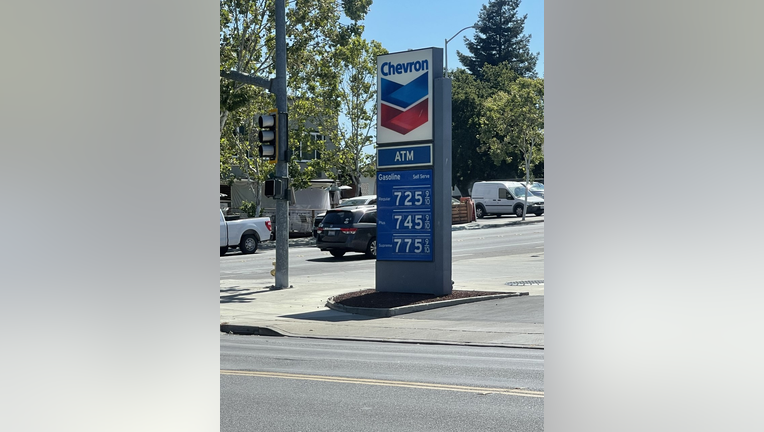Gas prices: $7.25 at one Bay Area station ahead of Memorial Day

At the Chevron on Alameda de las Pulgas in Menlo Park, a gallon of regular unleaded hit $7.25 on Tuesday, May 24, 2022. (Photo credit: Miguel Flores from Menlo Park Barber)
MENLO PARK, Calif. - Motorists may be feeling there’s no end in sight to the rising prices at the pump, as gas prices continued to break records.
This, as one Bay Area gas station was getting a lot of attention for the sticker shock it’s causing.
In Menlo Park, the Chevron on Alameda de las Pulgas hit $7.25 a gallon for regular unleaded and $7.75 for premium on Tuesday.
It was down a few cents from the previous day.
SEE ALSO: 'Oil refiners exploited the crisis': Report shows oil refiners are gouging California drivers
SEE ALSO: California gas prices hit $6 a gallon average; new record high
In the Bay Area and across the country, gas prices continued to soar to record highs, ahead of Memorial Day, the unofficial kick-off to the summer driving season when prices at the pump typically rise.
For the first time ever, the average for a gallon of regular unleaded topped $4 in all 50 states. The national average stood at $4.59 a gallon, the highest ever recorded, according to the American Automobile Association (AAA).
Compare that with the statewide average of $6.06, also a record high.
And as most Bay Area motorists were well aware, prices in this region tend to be even higher.
Here’s a snapshot of the average price for a gallon of regular unleaded across the Bay Area:
- Napa: $6.323
- Oakland $6.172
- San Francisco $6.298
- San Jose $6.174
- San Rafael $6.280
- Santa Rosa $6.247
- Vallejo-Fairfield $6.048
Industry analysts blamed the soaring costs on tight supplies, the volatile crude oil market, and Russia’s ongoing war in Ukraine.
"Gasoline is $1.05 more than it was on February 24, when Russia invaded Ukraine," said Andrew Gross, AAA spokesperson. "That sent shock waves through the oil market that have kept oil costs elevated."
AAA said that despite the pain at the pump, demand still remained high, which also fueled the high prices. "Domestically, meanwhile, seasonal gas demand is rising as more drivers hit the road," Gross said.
The agency noted that there were some steps motorists could take to help save fuel and money.
They include:
- Taking your car to the shop when the "check engine" light comes on. Your vehicle may be experiencing a problem that’s causing excessive emissions and likely reducing fuel economy.
- Keeping tires properly inflated. Under-inflated tires reduces fuel economy.
- Slowing down and driving the speed limit. On the highway, aerodynamic drag causes fuel economy to drop off significantly as speeds increase faster than 50 miles per hour.
- Avoid "jackrabbit" starts and hard acceleration, which significantly increase fuel consumption.
- Avoid prolonged idling. If your car will be stopped for more than 60 seconds, shut off the engine to save fuel.
- Adjust driving speed to time traffic lights to reduce repeated braking and acceleration, which consumes additional fuel.
- When possible, use cruise control to help maintain a constant speed which helps save fuel.
For more fuel saving tips click here.

